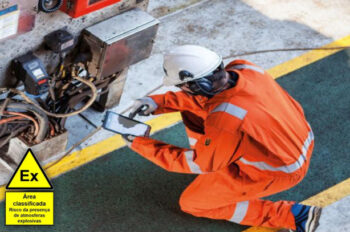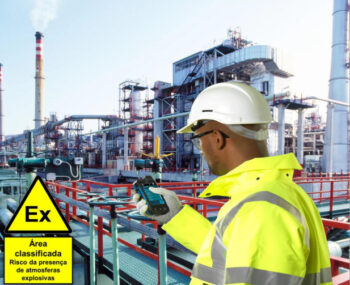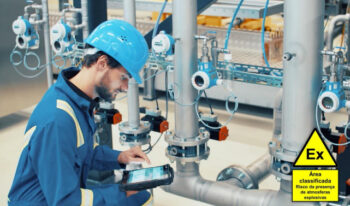Synopsis: This Technical Article addresses the criteria for the technical specification for the purchase and use of portable, personal, and hand-held “Ex” equipment to be used in hazardous areas containing flammable gases or combustible dust, such as “Ex” Smartphones, Tablets or Wearables, based on the requirements presented in the Brazilian Technical Standards adopted from the ABNT NBR IEC 60079 Series – Explosive Atmospheres.
Due to technological developments over the last few decades, the use of portable or personal “Ex” equipment in hazardous areas is becoming increasingly common. This trend stems from the need to use smartphones, tablets, walkie-talkies, or “Ex” wearables to carry out field services, including operating, maintenance and inspection procedures for equipment and installations, as well as photographic records and personal communication in hazardous areas containing flammable gases or combustible dusts.
The availability of mobile data signals and Wi-Fi networks in hazardous areas makes it increasingly easy to use these portable or personal “Ex” devices, providing greater connectivity between personnel working in places where explosive atmospheres may be present and supervisory, operational, or engineering personnel located in remote places. This type of connectivity can also be obtained for on-line connection to asset management systems and databases of “Ex” instrumentation, automation, telecommunications, electrical and mechanical equipment installed in explosive atmospheres.
It should be noted that portable, personal and wearable equipment to be used in hazardous areas containing flammable gases or combustible dusts can represent ignition sources and cause accidents with catastrophic consequences, which is why they must undergo conformity assessment and “Ex” certification processes, in accordance with current legal requirements.
According to the adopted Brazilian Technical Standard ABNT NBR IEC 60079-14 (Explosive atmospheres – Part 14: Design, selection, and assembly of electrical installations), “electrical or electronic equipment that may be used or temporarily transported inside hazardous areas must have an appropriate level of equipment protection”. In addition, this equipment must be suitable for the Zone (EPL), Group and Temperature Class of the most rigorous location where it may be used or transported.
Also, in accordance with the requirements presented in the adopted Brazilian Technical Standard ABNT NBR IEC 60079-14, due to the need and high flexibility of use, transportable, portable, or personal equipment can be used in different hazardous areas. “Ex” equipment that provides a lower EPL (Equipment Protection Level) (EPL Gc or Dc, for example) cannot be used or transported inside an area that requires a higher EPL (Gb or Dc, for example), unless it is otherwise protected. In practice, these limitations can be difficult to manage, especially with portable equipment.
It is therefore recommended that all transportable, portable, and personal “Ex” equipment meets the requirements of the location in which the equipment may be used that requires a HIGHER EPL.
Similarly, it is recommended that the equipment GROUP and TEMPERATURE CLASS be appropriate for all types of flammable gases or combustible dusts existing in the locations where this “Ex” equipment may be used.
It should be noted that there is a range of Ex-certified portable, personal, and wearable equipment available on the market, such as tablets, notebooks, smartphones (with or without integrated GPS), walkie-talkies, smartwatches, smart bands, wristbands, wearables, cameras, PDAs (Personal Digital Assistants), hand-held and portable luminaires, RFID-type electronic tags, infrared thermal imaging cameras and testing and measuring instruments. This portable or personal equipment generally provides EPL Gb or Db and is therefore suitable for use in hazardous areas such as Zones 1, 2, 21 and 22.
According to the legal requirements in force in Brazil, all “Ex” equipment for fixed installation or personal or portable use, for explosive atmospheres of flammable gases or combustible dusts must have a certificate of conformity issued by a Certification Body accredited by Inmetro.
According to ABNT NBR IEC 60079-14, “popular” personal devices such as smartwatches, wristbands or smart bands must also have the appropriate “Ex” conformity certification. The use of these devices without certification in hazardous areas is not permitted, from an industrial safety point of view, and because of the lack of, or difficulty in applying, procedures to verify that this equipment has in fact been assessed or certified before being transported into hazardous areas. This type of safety procedure also aims to ensure that “popular” equipment, purchased by users themselves, without the appropriate “Ex” certification, is not improperly used in hazardous areas, which would compromise the safety of installations in explosive atmospheres.
Example of using an “Ex” certified tablet for inspection services of instrumentation, automation, telecommunications, electrical and mechanical “Ex” equipment and installations in hazardous areas containing explosive atmospheres of flammable gases or combustible dusts
Since there are several Zone 1 and Zone 21 classified areas and other Group IIC and Group IIIB areas in various installations in the petrochemical and oil & gas industries, in which portable and personal “Ex” equipment can be taken and used, the specification must meet the most stringent area classification requirements, to meet the normative requirements specified in the adopted Brazilian Technical Standard ABNT NBR IEC 60079-14. In this case, the portable or personal “Ex” equipment to be specified must provide EPL Gb and Db, while also being suitable for Group IIC (flammable gases) and Group IIIB (combustible dusts).
Regarding the temperature class, the equipment must generally meet the requirements of T4 (gases) or a surface temperature of 125 ºC (dust). Because portable or personal “Ex” equipment is made with electronic components, which dissipate a low amount of heat, the temperature class provided by this “Ex” equipment generally has lower values than these.
For example, in the case of industrial installations containing areas classified for flammable gases and combustible dusts of different characteristics, such as Zone 1, Zone 2, Zone 21 and Zone 22, flammable gases of Groups IIB and IIC, flammable gases with temperature classes T4, T3, T2 and T1 and combustible dusts of Group IIIB with an ignition temperature of between 250 ºC and 150 ºC, there is a need for technical specifications for the purchase of tablets, cameras, portable lamps, smartphones, wearables. walkie-talkies or other personal or portable “Ex” equipment that meet the most stringent characteristics of the locations where they may be used.
In this example, the equipment must have, for example, specifications for use in Classified areas the types of Zones 1 and Zone 21, EPL Gb and Db, Groups IIC, IIIB and IIIC, Temperature Class T4 (for flammable gases), maximum surface temperature of 135 ºC (for combustible dust), or other even stricter specifications.
Example of using an “Ex” certified smartphone for inspection services of instrumentation, automation, telecommunications, electrical and mechanical “Ex” equipment and installations in hazardous areas containing explosive atmospheres of flammable gases or combustible dusts
It should be noted, from a market point of view, that there are now smartphones, tablets, wearables, and walkie-talkies that meet these EPL Gb and Db requirements, which are also common requirements for refineries, platforms and facilities in the chemical, petrochemical, pharmaceutical, food, agribusiness, steel, and mining industries in many countries around the world.
Many companies in the oil, petrochemical, agribusiness, and port industries that have classified areas containing explosive atmospheres formed by flammable gases or combustible dusts have already been using RFID (Radio Frequency Identification) devices extensively for many years in several of their operating units for the electronic and digital identification of “Ex” equipment installed in the field, by scanning these electronic TAGs by radio frequency using “Ex” Smartphones or Tablets.
Example of the use of an “Ex” certified smartphone for inspection services of instrumentation, automation, telecommunications, electrical and mechanical “Ex” equipment and installations in hazardous areas containing explosive atmospheres of flammable gases or other gases.
The adopted Brazilian Technical Standard ABNT NBR IEC 63365 (Measurement, control, and automation of industrial processes – Digital Marking) presents the RFID requirements to be used for the digital marking of “Ex” instrumentation, automation, telecommunications, electrical and mechanical equipment, to be read by “Ex” smartphones or tablets.
There are also existing applications in which RFID electronic identifiers are used to identify process equipment such as pressure vessels, storage tanks, pumps, fans, compressors, reactors, furnaces, boilers, heat exchangers and fractionation towers.
In these installations there are thousands of RFIDs that are permanently attached to process equipment or “Ex” equipment by means of adhesive glue or metal clamps, thus conveniently dispensing with the need to drill into existing equipment (such as pressure vessels or equipment with “explosion-proof” enclosures).
It is a trend that these RFID devices will also be used for the electronic identification of “Ex” instrumentation, automation, telecommunications, electrical or electronic equipment installed in hazardous areas containing flammable gases or combustible dusts, with the aim of improving the activities of initial and periodic “Ex” inspections, based on the Brazilian Technical Standard ABNT NBR IEC 60079-17 – Inspection and maintenance of equipment and installations in explosive atmospheres.
Example of using an “Ex” certified tablet for inspection services of instrumentation, automation, telecommunications, electrical and mechanical “Ex” equipment and installations in hazardous areas containing explosive atmospheres of flammable gases or combustible dusts
Also, regarding the use of personal equipment in hazardous areas, the adopted Brazilian Technical Standard ABNT NBR IEC 60079-14 specifies that “items of personal equipment that are powered by batteries or solar energy are sometimes carried by people and inadvertently taken into hazardous areas. A “simple” electronic wristwatch is an example of a low-power electronic device that has been independently assessed and found to be “acceptable” for use in a hazardous area under both historical and current (EPL) requirements. All other battery-powered or solar-powered personal equipment, including electronic wristwatches incorporating other functions such as Bluetooth communication or an integrated GPS system, must:
a) conform to the type of “Ex” protection appropriate for the EPL required by the most stringent area classification into which the personal equipment may be transported, as well as appropriate for the gas, group, sub-group, and temperature class requirements, or
b) be subject to a risk assessment by the owners of the “Ex” installations, orc) be taken inside a classified area in accordance with a “permit to work safely” procedure.
c) be taken inside a hazardous area in accordance with a “safe work permit” procedure.
The use of uncertified personal or portable products in hazardous areas is only permitted with a “prior work permit”. The procedure for obtaining this type of “Work Permit” is specified in Annex B of the adopted Brazilian Technical Standard ABNT NBR IEC 60079-14, which deals with “Guidance for safe working procedures for explosive gas atmospheres”.
In practice, this procedure represents the issue of a Work Permit, including the need to carry a “four gas” explosimeter for continuous monitoring of explosivity in the environment, in order to ensure that the area in which the equipment is used without certification is free of explosive atmospheres for the duration of the work or the validity of the Work Permit.
It should be noted that, from an industrial safety point of view, many companies do not even allow cell phones to be carried in industrial areas, regardless of whether the person is their own employee or a contractor, or whether the area is classified or not, or whether the cell phone has “Ex” certification or not. This is due to the need for strict attention to the work being carried out, without diverting attention or “distraction” to accessing social networking applications or sending or receiving personal messages. In these cases, the use of smartphones is restricted to predetermined locations, located in unclassified areas, outside industrial areas.
Roberval Bulgarelli
Consultant on equipment and installations in explosive atmospheres
Electrical engineer with a master’s degree in power system protection
Organizer of the book “The total life cycle of equipment and installations in explosive atmospheres”
Member of Study Committees of Subcommittee SCB 003:031 (Explosive atmospheres) of ABNT/CB-003 (Electricity)
Member of IEC Working Groups TC 31 (Equipment for explosive atmospheres)
Member of IECEx Working Groups (International Ex Certification System)
https://www.linkedin.com/in/roberval-bulgarelli/




